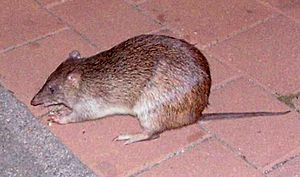Northern brown bandicoot facts for kids
Quick facts for kids Northern brown bandicoot |
|
|---|---|
 |
|
| Queensland, Australia | |
| Conservation status | |
| Scientific classification | |
| Genus: |
Isoodon
|
| Species: |
macrourus
|
 |
|
| Northern brown bandicoot range (blue — extant, black — extinct) |
|
The northern brown bandicoot (Isoodon macrourus) is a special type of marsupial. It's a small animal found along the northern and eastern coasts of Australia. You can also find it on nearby islands, especially in Papua New Guinea. These bandicoots don't live far inland.
In western Arnhem Land, the Kunwinjku people call the northern brown bandicoot Yok. For those still living on their traditional lands, it's an important food. They cook it in a special way: they stuff it with hot coals and bush herbs, then cover it with paperbark and cook it in an oven dug in the ground.
Contents
What the Northern Brown Bandicoot Looks Like
This bandicoot has some unique features that set it apart from other marsupials. It has several pairs of lower front teeth. Also, its second and third toes are joined together.
A northern brown bandicoot's body is usually about 40 cm (16 inches) long. Its tail adds another 15 cm (6 inches). On average, it weighs about 1200 grams (2.6 pounds). This marsupial has a thick, rough coat, but it's not spiny. Its back is light brown with black speckles. Its belly is solid white.
The northern brown bandicoot has a special pouch that opens backwards. This helps keep soil out when the bandicoot is digging. It also has short, round ears and a short nose.
It's easy to confuse the northern brown bandicoot with the southern brown bandicoot. But there are two main differences. The northern brown bandicoot is larger. Also, the southern brown bandicoot lives only on the southern coast of Australia.
Male bandicoots are usually 5 to 7 cm (2 to 2.8 inches) longer than females. They are also about 0.5 kg (1.1 pounds) heavier.
Where They Live and What They Eat
Northern brown bandicoots live in different places depending on the season. During the dry season, they prefer thick plants. This includes tall weeds, small trees, and dense bushes. They likely do this because food is harder to find then.
But during the wet season, these bandicoots move into open grasslands. Here, they can find much more food.
The northern brown bandicoot is one of the few native Australian mammals that can live in cities. They can survive because they aren't picky about what they eat or where they live. They also have many babies, which helps them survive in city areas.
These bandicoots build their own nests or homes on the ground. They are simple mounds of hay and twigs. These nests are well hidden and waterproof. Inside, they are hollow and just big enough for one bandicoot. Some bandicoots use hollow tree trunks or old rabbit holes for shelter. But generally, they like to build their homes in areas with low ground cover.
The northern brown bandicoot eats both plants and animals. This means it is an omnivore. It eats insects, earthworms, berries, and grass seeds. Sometimes, if there isn't enough food, a mother bandicoot might even eat her own young.
This marsupial looks for food alone at night. It has a very good sense of smell. This helps it find food that is either on the ground or buried. However, hunting at night can be dangerous. Many nocturnal animals in Australia hunt bandicoots. These include cats, foxes, and owls.
Life Cycle and Reproduction
The northern brown bandicoot carefully marks and protects its territory. It has special scent glands on its ears, mouth, pouch, and cloaca. This helps it mark its area. These bandicoots are solitary, meaning they live alone. They are only aggressive towards other bandicoots of their own species.
If a bandicoot is surprised in its nest, it will run away. A northern brown bandicoot will almost never fight back. The only exception is when two males fight over territory. In these fights, one male might be killed. Or, one male might become weaker and avoid future fights. Bandicoots are not social animals. They do not live in groups, except for a mother and her young.
Northern brown bandicoots can breed all year long. A mother usually has 2 to 4 babies in each litter. Like all marsupials, the newborns are born very tiny and undeveloped. They continue to grow inside the mother's pouch. The time they spend in the womb is very short, only about 12.5 days. This is the shortest known gestation period for any mammal!
Bandicoots are also unique among marsupials. They have a placenta that is similar to those of other mammals. Young bandicoots stop drinking milk at about 60 days old. By this time, they can keep their own body temperature stable. I. macrourus usually live for about two years.
Female bandicoots can have between 8 and 11 litters in their lifetime. Male bandicoots do not help care for the young.
The name "bandicoot" comes from an old Indian word, "pandi-kokku." This means "pig-rat." The name was given because bandicoots look a bit like rats.
Conservation Status
Over the last 100 years, the number of northern brown bandicoots has gone down. This happened after Europeans brought rabbits and livestock (like cows and sheep) to Australia. These new animals competed directly with bandicoots for food and places to live.
Bandicoot numbers also dropped when foxes and cats were brought to Australia. Both of these animals hunt small animals, including bandicoots.
See also
 In Spanish: Bandicut marrón septentrional para niños
In Spanish: Bandicut marrón septentrional para niños



